ASUS has been taking a cautious approach to its new phones, at a time when rivals continue to churn out a mix of flagship and midrange devices. Take the ROG Phone 3: it’s basically just an updated ROG Phone II. The same goes for the ZenFone 7 series announced today, with both models being (pretty much) scaled-up, 5G-capable versions of the ZenFone 6.
Apparently people really liked the flip camera on the ZenFone 6, so much that ASUS decided to keep this feature for its 2020 flagship. It means you can use the main cameras for better selfies, instead of making do with a weaker punch-hole camera. This new flip camera comes with three cameras instead of two.
The ZenFone 7 series consists of two models: the ZenFone 7 Pro and the near-identical ZenFone 7. I’ll be focusing on the Pro here, since that’s the one I’ve been playing with.
Gallery: ASUS ZenFone 7 Pro hands-on | 19 Photos
In addition to the 64-megapixel f/1.8 main camera and the 12-megapixel f/2.2 ultra-wide camera, the ZenFone 7 Pro’s flip camera module has gained an 8-megapixel f/2.4 telephoto camera, which offers 3x fixed optical zoom (and up to 12x digital zoom). As a bonus, both the main camera and the telephoto camera come with 4-axis OIS (optical image stabilization).
ASUS claims that the cameras here perform significantly better than last year’s model. The main camera is powered by Sony’s IMX686 imaging sensor, which can apparently capture four times the brightness than before in low-light conditions. The sensor is also capable of recording video at up to 8K at 30fps or 4K slow motion at 120fps, making the phone a versatile video camera.
For the ultra-wide camera, ASUS decided to go with the new IMX363 sensor, which has its pros and cons: it features a slightly lower resolution and field of view than last year’s camera module, but in return, it packs larger 1.4um pixels for better light sensitivity, along with dual pixel autofocus and macro mode (down to 4cm). This is a wise decision for improving both landscape photography and group selfies, especially when lighting isn’t ideal. The new sensor can also handle 4K capture at up to 60fps, along with “HyperSteady” electronic stabilization and real-time distortion correction.
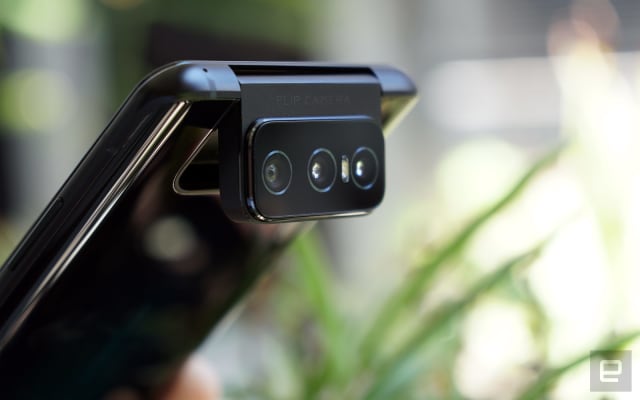
All these camera benefits apply to both front and rear capture. Or at any angle, for that matter -- just press and hold the flip button in the camera app or use the volume keys to manually adjust the angle. This is particularly handy if your subject is placed at an awkward height or position. There are also three customizable angle buttons -- you can press and hold to save a new angle.
Sadly, the unit I received wasn’t carrying the finished camera software, so ASUS told me the image quality wasn’t representative of the product. I’ll update this article with some sample shots once my phone gets the final update.
Another major, but less obvious, update to the flip camera is its moving mechanism. According to ASUS, the ZenFone 7 series’ stepper motor is 40-percent smaller than before, yet it’s capable of 2.2 times more torque to handle the heavier module with a faster rotation. Its redesigned gearbox and a new angle sensor also allow more precise movements, going from the old 2-degree steps to smaller 0.5-degree steps.
Even the level of durability has been doubled to 200,000 continuous flips, according to ASUS. This equates to over five years of usage if you flipped the camera 100 times per day (which is, of course, rather excessive). Like before, if you drop the phone while attempting a selfie, the camera will automatically retract during the fall. That said, the ZenFone 7 series isn’t waterproof due to the nature of the flip camera design, so you’ll want to keep the phone away from liquids.
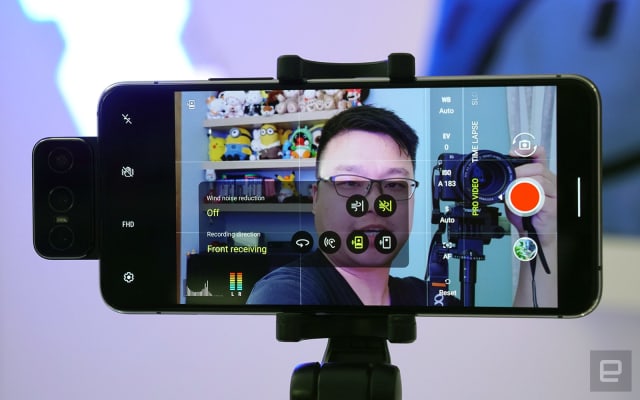
The new flip camera supports improved auto panorama and motion tracking video recording, with the former now compatible with the ultra-wide camera for some wider panorama shots. The more demanding users will also enjoy new features like independent focus point and exposure point controls, along with the Pro Video mode which lets you tinker with the ISO, shutter speed, white balance and more.
It’s worth mentioning that the ZenFone 7 series comes with not two but three microphones for better noise cancellation. These add the ability to focus on the sound coming from a subject, and you can even pick the audio direction (front, back or all directions) when recording in Pro Video mode.
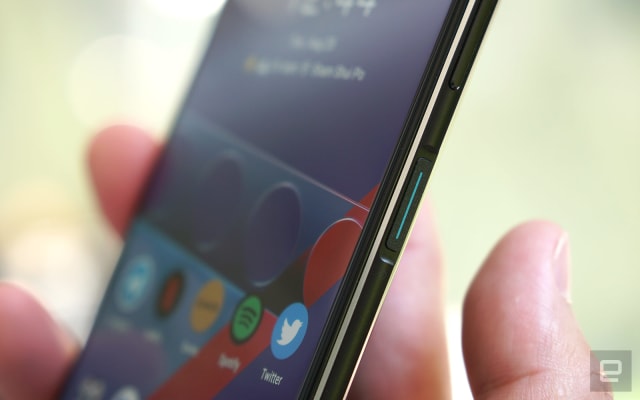
Another physical feature worthy of a mention is the new “Smart Key.” It’s actually just the power button with an integrated fingerprint reader, but it also doubles as a multi-function key. This is a cunning approach, as this all-in-one Smart Key can be customized to instantly unlock and toggle an app or action in one go; or you can leave it as-is for summoning Google Assistant.
In terms of core specs, the ZenFone 7 Pro shares the same Qualcomm Snapdragon 865 Plus processor as the ROG Phone 3. It comes with 8GB of LPDDR5 RAM, 256GB of UFS 3.1 storage, microSD expansion (up to 2TB) and dual SIM slots. Nothing surprising here for a flagship, of course, so it’s really all about that flip camera.
And if it weren’t for the third camera and the relocated fingerprint reader, you’d easily mistake the ZenFone 7 Pro for the ZenFone 6. When placed side by side, though, you’ll see the new device is much larger. Despite carrying the same generous 5,000mAh battery, the ZenFone 7 Pro is also a lot heavier, weighing 230g (about 8.1 ounces) compared to its 190g (about 6.7 ounces) predecessor; though this shouldn’t be a problem for those who are accustomed to the iPhone 11 Pro Max.
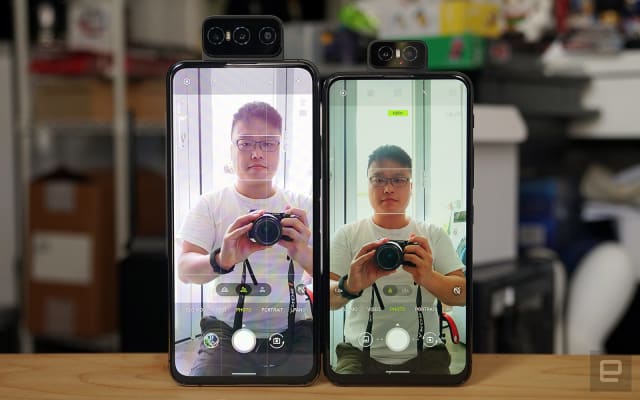
The ZenFone 7 Pro has a 6.67-inch Samsung AMOLED panel, which features a slick 90Hz refresh rate and 200Hz touch sampling rate, along with a longer aspect ratio (2,400 x 1,080) and a maximum outdoor brightness of 700 nits -- about the same as what you’d get on the latest flagships from Samsung and Apple. You also get HDR10+ support, which already works with Netflix; just too bad about the lack of front-facing stereo speakers here.
ASUS threw in a 30W adapter which supports Quick Charge 4.0 protocol, and this can get the 5,000mAh battery up to 60-percent charge in 34 minutes, or 100-percent charge in 93 minutes. Also included in the box are two protection cases: a hard transparent case and a more rugged black “Active Case” -- the latter has a latch to lock the flip camera in place for better protection.
If you were looking for something a little cheaper, the lesser ZenFone 7 is almost identical to its Pro counterpart, except it packs the less powerful Snapdragon 865 processor along with both 6GB and 8GB RAM options, a smaller 128GB storage and cameras sans OIS.
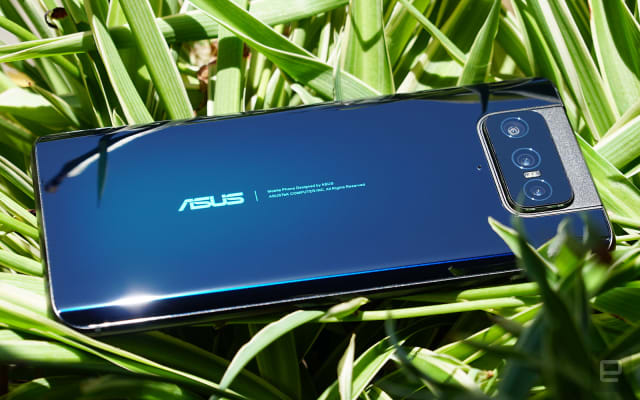
The ZenFone 7 series will launch in Taiwan first, with pre-orders starting today. The ZenFone 7 Pro will start from NT$27,990 (about US$950) with 8GB RAM and 256GB storage, whereas the more affordable ZenFone 7 is priced starting at NT$21,999 (about US$750) with 6GB RAM and 128GB storage.
Alas, ASUS has confirmed to Engadget that the ZenFone 7 series won’t be heading to North America, mainly due to the lack of most US 5G bands on the devices. Folks in Europe, however, can look out for a local launch as early as September 1st.
Technology - Latest - Google News
August 26, 2020 at 02:32PM
https://ift.tt/3gqh2Cx
ASUS kept the flippable camera for the flagship ZenFone 7 Pro - Engadget
Technology - Latest - Google News
https://ift.tt/2AaD5dD
Shoes Man Tutorial
Pos News Update
Meme Update
Korean Entertainment News
Japan News Update
Bagikan Berita Ini



















0 Response to "ASUS kept the flippable camera for the flagship ZenFone 7 Pro - Engadget"
Post a Comment